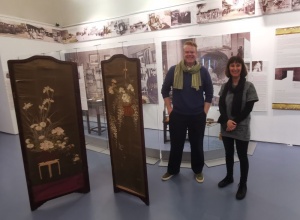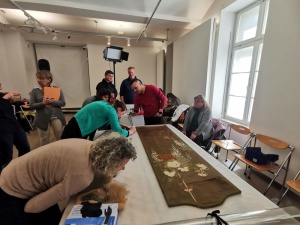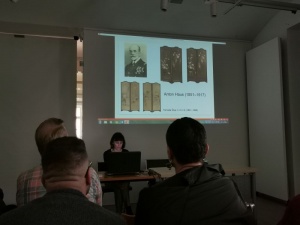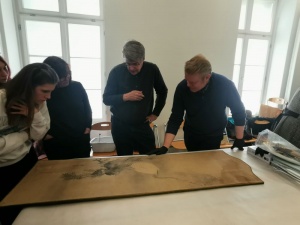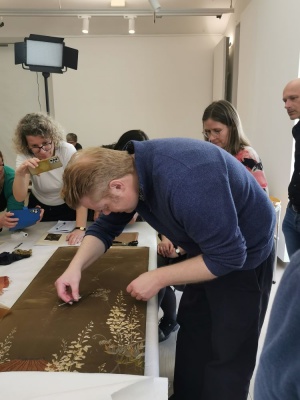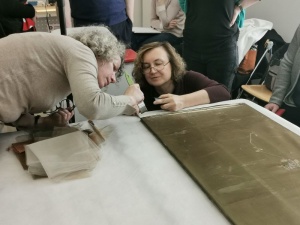International Symposium Japanese Embroidered Folding Screens: Problems in Restoration
From 19 to 21 March 2024, an international symposium with the workshop Japanese Embroidered Folding Screens: Difficulties in Restoration was hosted by the Slovenian Ethnographic Museum and the Celje Provincial Museum, in which the distinguished restorer Howard Sutcliffe and the Director of the River Region Costume and Textile Conservation in Arley, Alabama, and in Nashville, Tennessee (USA), demonstrated the restoration procedures on the Japanese folding screen from the legacy of the Grand Admiral Anton Haus (1851--1917), which is held by the Maritime Museum Piran.
Prior to the symposium, Howard Sutcliffe visited the Piran Maritime Museum, together with Dr Nataša Vempalj Suhadolnik from the Department of Asian Studies of the Faculty of Arts in Ljubljana, where Bogdana Marinac acquainted him with Anton Haus' folding screen, the exhibition Fragments of the Far East, and the museum’s permanent exhibitions.
The symposium/workshop was organized as part of the Orphaned Objects project, a discussion on East Asian objects outside the organized collecting practices in Slovenia, which is led by the Department of Asian Studies of the Faculty of Arts in Ljubljana and the Koper Science and Research Center, in which the regional Museum Celje, the National Museum and the Piran Maritime Museum are also taking part. The Slovenian Ethnographic Museum, the Provincial Museum of Ptuj-Ormož and the Archives of the Republic of Slovenia participated in the organization of the workshop.
At the symposium, the following experts spoke about Japanese embroideries and folding screens: Hans Bjarne Thomsen from the University of Zurich, Katharine Anne Paul from the Birmingham Museum of Art in Alabama (USA), and Nataša Vampelj Suhadolnik from the Faculty of Arts in Ljubljana. In addition to Howard Sutcliffe, Juliana Polte from the University Library in Dresden demonstrated some restoration methods.
The experts closely examined the folding screens held by the Slovenian Ethnographic Museum, the Provincial Museum Celje, the Piran Maritime Museum and Snežnik Castle, which led to many new insights into the origins of the screens and the various methods of their restoration.
Dr Hans Bjarne Thomsen established, together with Nataša Vampelj Suhadolnik, that the author of the silk folding screen paintings, which were brought from Japan by Grand Admiral Anton Haus in 1902, was the Japanese painter Yamada Ōsai 山田応哉 (1821-1846), who studied at the Maruyama-Shijō School of Painting in Kyoto.
Katharine Anne Paul inferred that the paintings depicting the four seasons had originally been intended to hang on the wall, and that the screen was made in the late 19th century. Although the four-part screen with a painting on silk on one side and embroidery on silk on the other side was made for export purposes, both the paintings and embroideries are of top quality.
